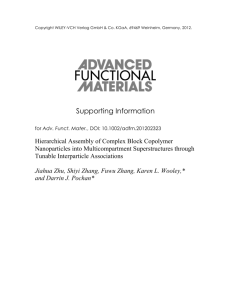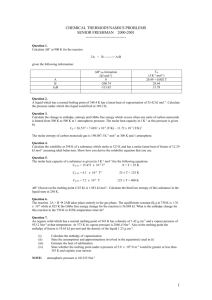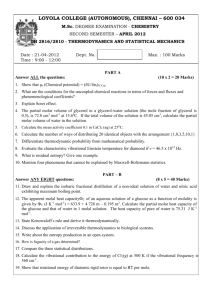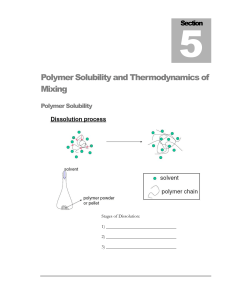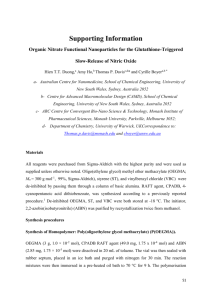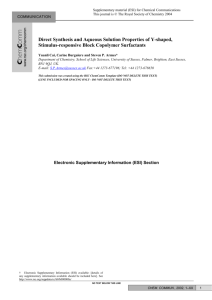Kotharangannagari_macromolecules_revised
advertisement
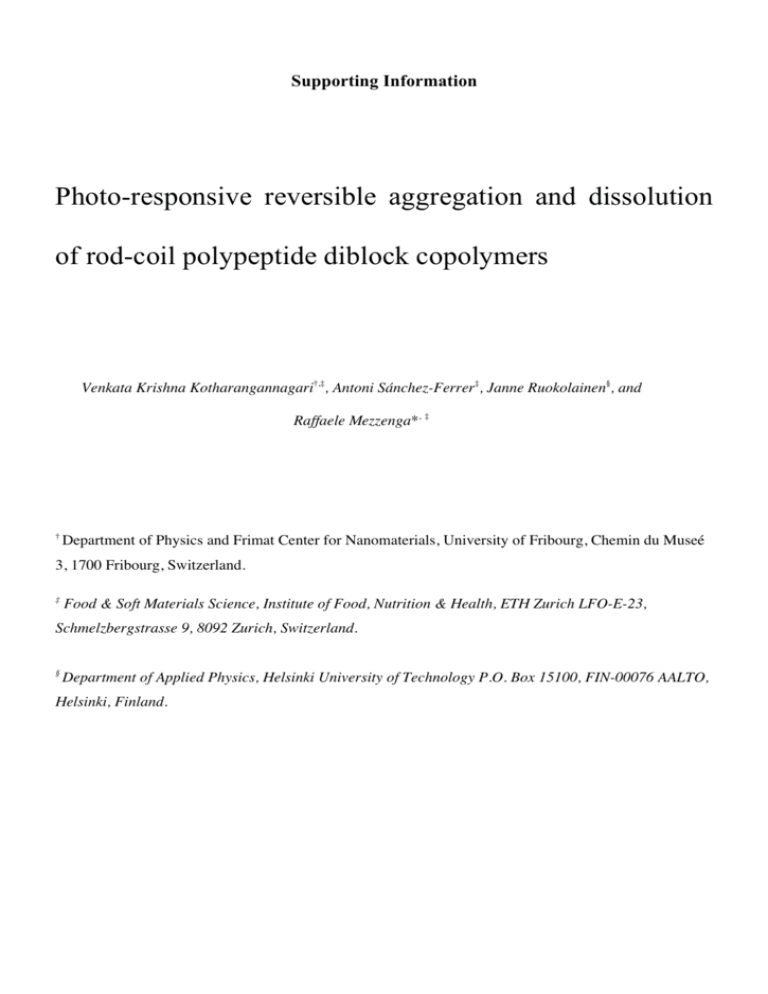
Supporting Information Photo-responsive reversible aggregation and dissolution of rod-coil polypeptide diblock copolymers Venkata Krishna Kotharangannagari†,‡, Antoni Sánchez-Ferrer‡, Janne Ruokolainen§, and Raffaele Mezzenga*, ‡ † Department of Physics and Frimat Center for Nanomaterials, University of Fribourg, Chemin du Museé 3, 1700 Fribourg, Switzerland. ‡ Food & Soft Materials Science, Institute of Food, Nutrition & Health, ETH Zurich LFO-E-23, Schmelzbergstrasse 9, 8092 Zurich, Switzerland. § Department of Applied Physics, Helsinki University of Technology P.O. Box 15100, FIN-00076 AALTO, Helsinki, Finland. Experimental section: Materials: L-glutamic acid γ-benzyl ester (Fluka, ≥ 99.0%), triphosgene (Aldrich, 98%), N,N-dimethylformamide – DMF – (Sigma-Aldrich, ≥ 99.8%, over molecular sieve), dichloromethane – DCM – (Acros, 99.99%), ethanol (Fluka, 99.8%), N,N’-dicyclohexylcarbodiimide – DCC - (Fluka, 99%), 4-dimethylaminopyridine – DMAP – (Sigma-Aldrich, ≥ 99%), triflouroacetic acid – TFA – (Fluka, 98%), Hydrobromic acid in glacial acetic acid (Sigma-Aldrich, 33%) were used as received. Ethyl acetate (Sigma-Aldrich, ≥ 99.9%) and cyclohexane (Sigma-Aldrich, ≥ 99.9%) were dried and distilled over CaH2 (Fluka, > 97.0%) at normal pressure. α-Methoxy-ɷ-amino-PEO macro initiators (Rapp Polymers GmbH, Mn = 20300 g⋅mol-1, PDI = 1.13 and Mn = 10400 g⋅mol-1, PDI = 1.24) were purchased from polymer source. 1-(2Hydroxyethyl)-3,3-dimethylindolino-6'-nitrobenzopyrylospiran (SP) was purchased from TCI Europe and used as received. Synthesis of (BLG-NCA) monomer: The monomer of BLG-NCA, (γ-Benzyl L-glutamate N-carboxyanhydride) was synthesized as follows: 10 g (42.1 mmol, 1 eq) of γ-benzyl L-glutamate and 5.42 g (18.3 mmol, 0.43 eq) of triphosgene were placed in a 500 mL two-necked round-bottomed flask, and equipped with a magnetic stirrer, condenser and nitrogen inlet. The system was purged with nitrogen during 10 minutes. Then 250 mL of freshly distilled ethyl acetate over CaH2 was added and the reaction mixture temperature was brought to 145 °C. After several hours (5-6 h), the reactants were completely soluble and the reaction was cooled down to room temperature. The monomer was obtained by recrystallization from ethyl acetate/cyclohexane. Yield: 10.2 g (92%). 1 H NMR (300 MHz, chloroform-d6): δ = 7.10-7.42 (5H, m, Ar), 6.62 (1H, s, NH), 5.04 (2H, s, Ar-CH2), 4.29 (1H, t, α-CH, J = 6.0 Hz), 2.50 (2H, t, γ-CH2, J = 6.6 Hz), 2.16 (1H, m, β-CH), 2.03 (1H, m, β-CH) ppm. Macroinitiator (PEO-NH2): PEO460. 1H NMR (300 MHz, chloroform-d6): δ = 3.48-3.79 (1840H, CH2CH2O), 3.35(3H, s, CH3) ppm. Mn = 20300 g⋅mol-1, GPC (THF, 1 mL/min): Mn = 21200 g⋅mol-1, PDI = 1.13 PEO235. 1H NMR (300 MHz, chloroform-d6): δ = 3.48-3.79 (940H, CH2CH2O), 3.35(3H, s, CH3) ppm. Mn = 10400 g⋅mol-1, GPC (THF, 1 mL/min): Mn = 13600 g⋅mol-1, PDI = 1.24 Synthesis of PBLG-b-PEO: In a 25 mL round-bottomed flask, the BLG-NCA monomer was dissolved in dry DMF under nitrogen atmosphere. In another 10 mL round bottomed flask, the amino-terminated polyethylene oxide (PEONH2) macroinitiator was dissolved in dry DMF under nitrogen atmosphere. Then the monomer solution was transferred to the polymer solution by syringe. The resulting mixture was stirred at room temperature for 5 days under nitrogen atmosphere. Afterwards, the solvent was removed under vacuum and the residue was dissolved in DCM. The resulting diblock copolymer was obtained as a white solid after reprecipitation with cold diethyl ether followed by centrifugation (3000 rpm, 0 °C) and removal of the supernatant (three times). Yield: 80-90%. PBLG20-b-PEO460. 1H NMR (300 MHz, chloroform-d6): δ = 8.10-8.70 (20H, NH), 7.10-7.40 (100H, Ar), 4.88-5.18 (40H, Ar-CH2), 3.80-4.04 (20H, α-CH), 3.48-3.79 (1840H, CH2CH2O), 3.33-3.36 (3H, s, CH3), 2.00-2.70 (80H, β-CH2 and γ-CH2) ppm. Mn = 24600 g⋅mol-1, GPC (THF, 1 mL/min): Mn = 21500 g⋅mol-1, PDI = 1.21 PBLG10-b-PEO235. 1H NMR (300 MHz, chloroform-d6): δ = 8.10-8.70 (10H, NH), 7.10-7.40 (50H, Ar), 4.88-5.18 (20H, Ar-CH2), 3.80-4.04 (10H, α-CH), 3.48-3.79 (940H, CH2CH2O), 3.33-3.36 (3H, s, CH3), 2.00-2.70 (40H, β-CH2 and γ-CH2) ppm. Mn = 12500 g⋅mol-1, GPC (THF, 1 mL/min): Mn = 11400 g⋅mol-1, PDI = 1.35 Synthesis of PLGA-b-PEO: In a 25 mL round-bottomed flask, 0.300 g of the diblock copolymer (PBLG-b-PEO) was dissolved in 2 mL of TFA at 0 °C. To the above solution, 1 mL of HBr in glacial acetic acid was added. Then the reaction was allowed at room temperature for 2 h. The polymer was precipitated by adding diethyl ether, solvents were removed under vacuum and the resulting polymer was dried at low pressure and room temperature for 24 h. Yield: 0.278 g (92%). PLGA20-b-PEO460. 1H NMR (300 MHz, DMSO-d6): 7.52-8.58 (20H, NH), 3.90-4.24 (20H, α-CH), 3.343.64 (1840H, CH2CH2O), 1.60-2.40 (80H, β-CH2 and γ-CH2) ppm. Mn = 22800 g⋅mol-1 PLGA10-b-PEO235. 1H NMR (300 MHz, DMSO-d6): 7.52-8.58 (10H, NH), 3.90-4.24 (10H, α-CH), 3.343.64 (940H, CH2CH2O), 1.60-2.40 (40H, β-CH2 and γ-CH2) ppm. Mn = 11600 g⋅mol-1 Synthesis of PLGASP-b-PEO: In a 25 mL round-bottomed flask, 100 mg of the deprotected block copolymer (PLGA-b-PEO) was dissolved in 2 mL of dry DMF. In another 25 mL round-bottomed flask, the spiropyran (2 eq), the DMAP (0.6 eq) and the DCC (1 eq) were dissolved in 3 mL of dry DMF and transferred to the polymer solution by syringe. Then the mixture was stirred at room temperature for 24 h. The polymer solution was filtered off to remove the byproduct (dicyclohexylurea). The polymer was precipitated by adding diethyl ether. The polymer was dissolved in DCM, reprecipitated with diethyl ether, and centrifuged at 3000 rpm and 0 °C (three times). The resulting polymer was dried at room temperature and under vacuum. PLGASP20-b-PEO460. 1H NMR (300 MHz, chloroform-d6): 8.10-8.70 (20H, NH), 7.82-8.04 (a and b), 6.98-7.20 (c and f), 6.76-6.96 (d and g), 6.45-6.75 (h and i), 5.70-5.98 (e), 3.55-3.98 (CH2CH2O, j and k), 3.98-4.36 (20H, α-CH), 1.60-2.80 (80H, β-CH2 and γ-CH2), 1.15-1.35 (CH3-SP) ppm. Mn = 26200 g⋅mol-1 PLGASP10-b-PEO235. 1H NMR (300 MHz, chloroform-d6): 8.10-8.70 (10H, NH), 7.82-8.04 (a and b), 6.98-7.20 (c and f), 6.76-6.96 (d and g), 6.45-6.75 (h and i), 5.70-5.98 (e), 3.55-3.98 (CH2CH2O, j and k), 3.98-4.36 (10H, α-CH), 1.60-2.80 (40H, β-CH2 and γ-CH2), 1.15-1.35 (CH3-SP) ppm. Mn = 13300 g⋅mol-1 Figure SI-1. GPC traces of the diblock copolymer PBLG20-b-PEO460 and the corresponding macroinitiator PEO460 0 A544(∞) - A544(t) 10 10 -1 τUV = 132 s k1+k2 = 0.0076 s 10 -1 -2 0 60 120 180 240 300 t (s) Figure SI-2. Kinetics of the SP-MC isomerization for the diblock copolymer PBLG20-b-PEO460 Figure SI-3. a) Photo-isomerization process for a 0.01 wt-% of PLGASP10-b-PEO235 micelles in a mixture of 90:10 H2O/EtOH, when irradiated with UV light (λ = 350 nm), and b) photo-back-isomerization process during irradiation with visible light (λ = 590 nm) -4 1.6x10 -4 1.5x10 -1 Kc/Rθ (mol·kg ) -4 1.4x10 -4 1.3x10 -4 1.2x10 ΣMw = 10877 kDa -4 1.1x10 -2 A2 = 2.9⋅10-5 mL⋅mol⋅g Mw = 33.4 kDa -4 1.0x10 Aggregation number = 326 -5 9.0x10 0.0 0.2 0.4 0.6 0.8 1.0 1.2 -3 c (kg·m ) Figure SI-4. Debye plot for the diblock copolymer PLGASP20-b-PEO460 in 90:10 H2O/EtOH Figure SI-5. CD spectra for the 0.1 wt-% solution in 90:10 H2O/EtOH of the block copolymer PLGASP10-b-PEO235 before, during UV irradiation, and after visible light exposure. Figure SI-6. Zeta-potential plot for the 0.1 wt-% solution in 90:10 H2O/EtOH of the block copolymer PLGASP20-b-PEO460 before (-10.30mv) and after UV irradiation (-9.06mv). Figure SI-7. UV-Vis spectra of spiropyran 3.10-5 M in 90:10 H2O/EtOH, and spiropyran 3.10-5 M in 90:10 H2O/EtOH in acidic conditions in the presence of 5.10-5 M AcOH. Table SI-1: pH measured on the block copolymer solutions before UV, after UV and after visible light exposure before UV UV 5min Vis 180 min PLGASP20-b-PEO460 pH at 0.1wt % 7.73 7.54 7.63 PLGASP10-b-PEO235 pH at 0.1wt % 7.82 7.68 7.72
